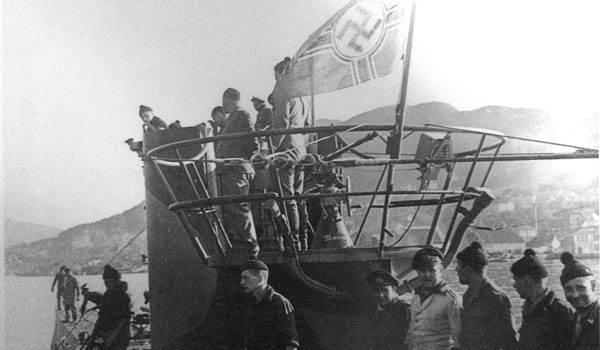Major Cocaine Bust: UK Border Force Seizes Record Shipment at London Gateway
In one of the UK’s largest drug seizures of the past decade, UK Border Force officers have seized cocaine with an estimated street value of £96 million (USD 130 million)...

U-576 crew gathered around the conning tower. Photo credit: NOAA
A team of researchers led by NOAA’s Office of National Marine Sanctuaries have discovered two significant shipwrecks from World War II’s legendary “Battle of the Atlantic” just off Cape Hatteras, North Carolina.
The German U-boat 576 and the freighter it sank, named Bluefields, were found just a few hundred yards apart from each other approximately 30 miles off the coast of North Carolina, according to NOAA. The discovery of the two vessels, lost for more than 70 years ago in what is known as Graveyard of the Atlantic, offers a rare glimpse into a historic military battle and is a stark reminder of just how close the front lines of World War II were to U.S. shores.
“This is not just the discovery of a single shipwreck,” said Joe Hoyt, a NOAA sanctuary scientist and chief scientist for the expedition. “We have discovered an important battle site that is part of the Battle of the Atlantic. These two ships rest only a few hundred yards apart and together help us interpret and share their forgotten stories.”
Lasting from September 1939 until the defeat of Germany in 1945, the Battle of the Atlantic is considered World War II’s longest continuous military campaign, highlighting the importance that control over vital Atlantic shipping lanes played in the War.
According to NOAA, on July 15, 1942, Convoy KS-520, a group of 19 merchant ships escorted by the U.S. Navy and Coast Guard, was en route to Key West, Florida, from Norfolk, Virginia, to deliver cargo to aid the war effort when it was attacked off Cape Hatteras. The U-576 sank the Nicaraguan flagged freighter Bluefields and severely damaged two other ships. In response, U.S. Navy Kingfisher aircraft, which provided the convoy’s air cover, bombed U-576 while the merchant ship Unicoi attacked it with its deck gun. Bluefields and U-576 were lost within minutes and now rest on the seabed less than 240 yards apart.
“Most people associate the Battle of the Atlantic with the cold, icy waters of the North Atlantic,” said David Alberg, superintendent of NOAA’s Monitor National Marine Sanctuary. “But few people realize how close the war actually came to America’s shores. As we learn more about the underwater battlefield, Bluefields and U-576 will provide additional insight into a relatively little-known chapter in American history.”
The discovery of U-576 and Bluefields is a result of a 2008 partnership between NOAA and the Bureau of Ocean Energy Management (BOEM) to survey and document vessels lost during WWII off the North Carolina coast. Earlier this year, in coordination with Monitor National Marine Sanctuary, NOAA Ship Okeanos Explorer conducted an initial survey based on archival research. In August, archaeologists aboard NOAA research vessel SRVX Sand Tiger located and confirmed the ships’ identities.
“This discovery highlights the importance of federal agencies working together to identify and protect these unique submerged archaeological resources that are of local and international importance,” said William Hoffman, a BOEM archaeologist.
The newly identified wrecks are protected by international law because they are considered war graves. Although Bluefields did not suffer any casualties during the sinking, the wreck site is a war grave for the crew of U-576, NOAA notes.
“In legal succession to the former German Reich, the Federal Republic of Germany, as a rule, sees itself as the owner of formally Reich-owned military assets, such as ship or aircraft wreckages,” said the German Foreign Office in a statement. “The Federal Republic of Germany is not interested in a recovery of the remnants of the U-576 and will not participate in any such project. It is international custom to view the wreckage of land, sea, and air vehicles assumed or presumed to hold the remains of fallen soldiers as war graves. As such, they are under special protection and should, if possible, remain at their site and location to allow the dead to rest in peace.”
United States policy on sunken state vessels, such as these, reaffirms sovereign government ownership of the wrecks, including German ownership of U-576. As stated in the 2001 Presidential Statement on United States Policy for the Protection of Sunken State Craft the wrecks are not considered abandoned nor does passage of time change their ownership.
Read more about and view high resolution images of the U-576 and Bluefields HERE.

Sign up for gCaptain’s newsletter and never miss an update

Subscribe to gCaptain Daily and stay informed with the latest global maritime and offshore news


Stay informed with the latest maritime and offshore news, delivered daily straight to your inbox
Essential news coupled with the finest maritime content sourced from across the globe.
Sign Up